Case Study: Corporate Law and Darwin Soil & Water Testing Pty Ltd
VerifiedAdded on 2023/06/12
|10
|2762
|299
Case Study
AI Summary
This case study analyzes the corporate law issues surrounding Darwin Soil and Water Testing Pty Ltd, a company owned by Ravi, focusing on its insolvency and subsequent administration. The company faced financial difficulties after losing its primary contractor, leading to the appointment of an administrator. The administrator assessed the company's assets and debts, including a secured loan to Ravi, and considered options such as returning the company to its director, executing a Deed of Company Arrangement (DOCA), or initiating liquidation. The analysis concludes that a DOCA is the most viable option, allowing the company to discharge its debts while continuing operations. However, Ravi's secured debt remains a priority if he doesn't vote for the DOCA approval, ensuring he receives payment before unsecured creditors. The case study references relevant sections of the Corporations Act 2001 and the Bluenergy Group Limited case to support its findings. Desklib provides access to this and other solved assignments to assist students in their studies.
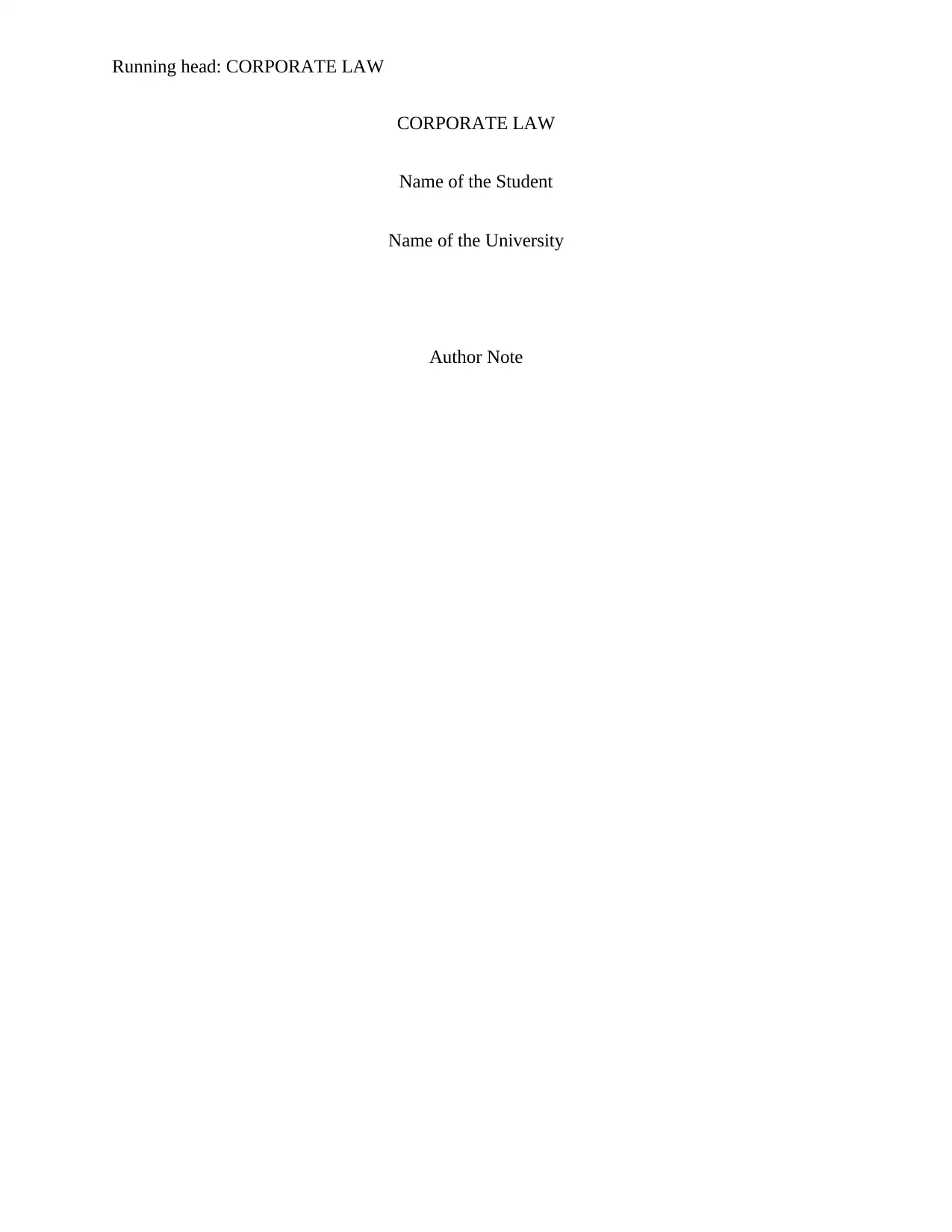
Running head: CORPORATE LAW
CORPORATE LAW
Name of the Student
Name of the University
Author Note
CORPORATE LAW
Name of the Student
Name of the University
Author Note
Paraphrase This Document
Need a fresh take? Get an instant paraphrase of this document with our AI Paraphraser
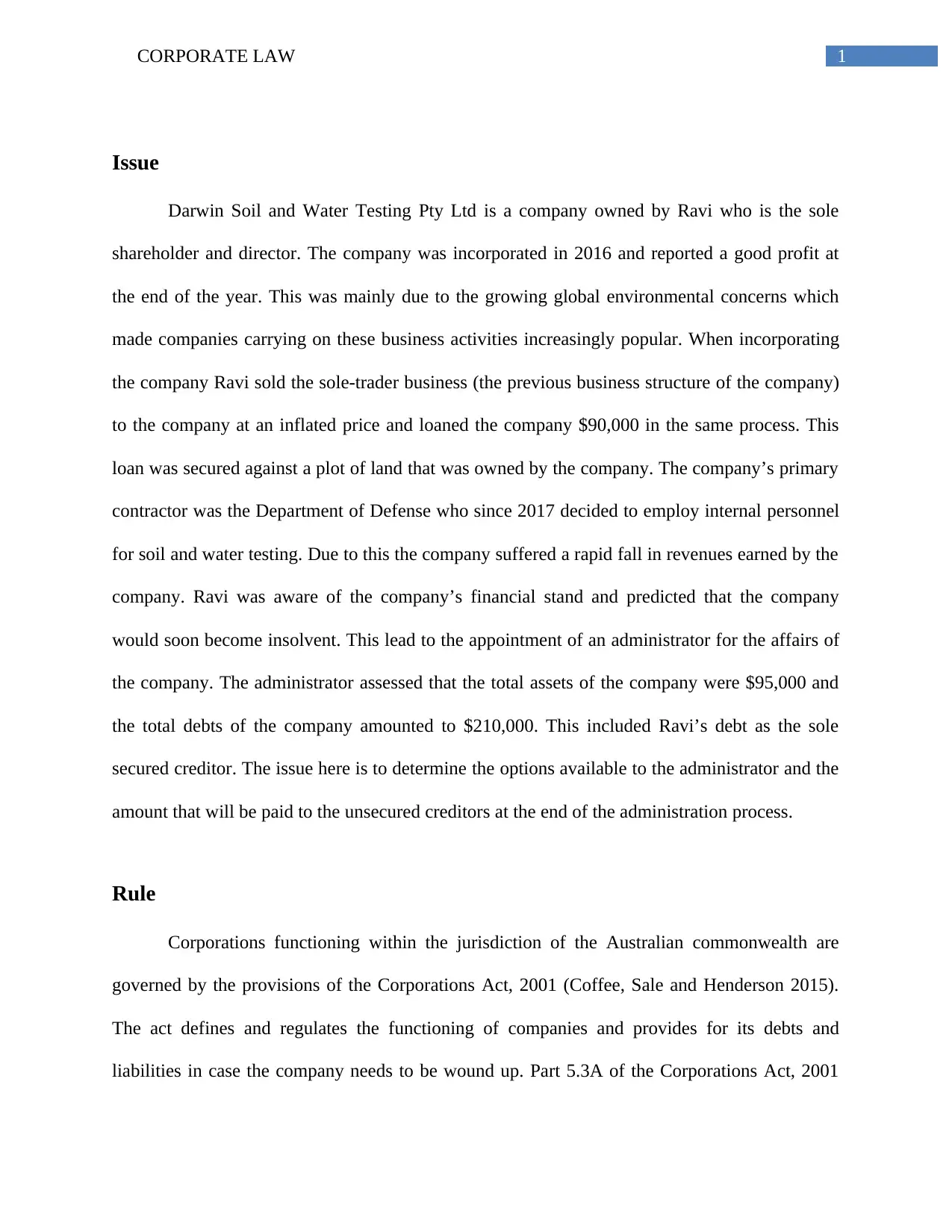
1CORPORATE LAW
Issue
Darwin Soil and Water Testing Pty Ltd is a company owned by Ravi who is the sole
shareholder and director. The company was incorporated in 2016 and reported a good profit at
the end of the year. This was mainly due to the growing global environmental concerns which
made companies carrying on these business activities increasingly popular. When incorporating
the company Ravi sold the sole-trader business (the previous business structure of the company)
to the company at an inflated price and loaned the company $90,000 in the same process. This
loan was secured against a plot of land that was owned by the company. The company’s primary
contractor was the Department of Defense who since 2017 decided to employ internal personnel
for soil and water testing. Due to this the company suffered a rapid fall in revenues earned by the
company. Ravi was aware of the company’s financial stand and predicted that the company
would soon become insolvent. This lead to the appointment of an administrator for the affairs of
the company. The administrator assessed that the total assets of the company were $95,000 and
the total debts of the company amounted to $210,000. This included Ravi’s debt as the sole
secured creditor. The issue here is to determine the options available to the administrator and the
amount that will be paid to the unsecured creditors at the end of the administration process.
Rule
Corporations functioning within the jurisdiction of the Australian commonwealth are
governed by the provisions of the Corporations Act, 2001 (Coffee, Sale and Henderson 2015).
The act defines and regulates the functioning of companies and provides for its debts and
liabilities in case the company needs to be wound up. Part 5.3A of the Corporations Act, 2001
Issue
Darwin Soil and Water Testing Pty Ltd is a company owned by Ravi who is the sole
shareholder and director. The company was incorporated in 2016 and reported a good profit at
the end of the year. This was mainly due to the growing global environmental concerns which
made companies carrying on these business activities increasingly popular. When incorporating
the company Ravi sold the sole-trader business (the previous business structure of the company)
to the company at an inflated price and loaned the company $90,000 in the same process. This
loan was secured against a plot of land that was owned by the company. The company’s primary
contractor was the Department of Defense who since 2017 decided to employ internal personnel
for soil and water testing. Due to this the company suffered a rapid fall in revenues earned by the
company. Ravi was aware of the company’s financial stand and predicted that the company
would soon become insolvent. This lead to the appointment of an administrator for the affairs of
the company. The administrator assessed that the total assets of the company were $95,000 and
the total debts of the company amounted to $210,000. This included Ravi’s debt as the sole
secured creditor. The issue here is to determine the options available to the administrator and the
amount that will be paid to the unsecured creditors at the end of the administration process.
Rule
Corporations functioning within the jurisdiction of the Australian commonwealth are
governed by the provisions of the Corporations Act, 2001 (Coffee, Sale and Henderson 2015).
The act defines and regulates the functioning of companies and provides for its debts and
liabilities in case the company needs to be wound up. Part 5.3A of the Corporations Act, 2001
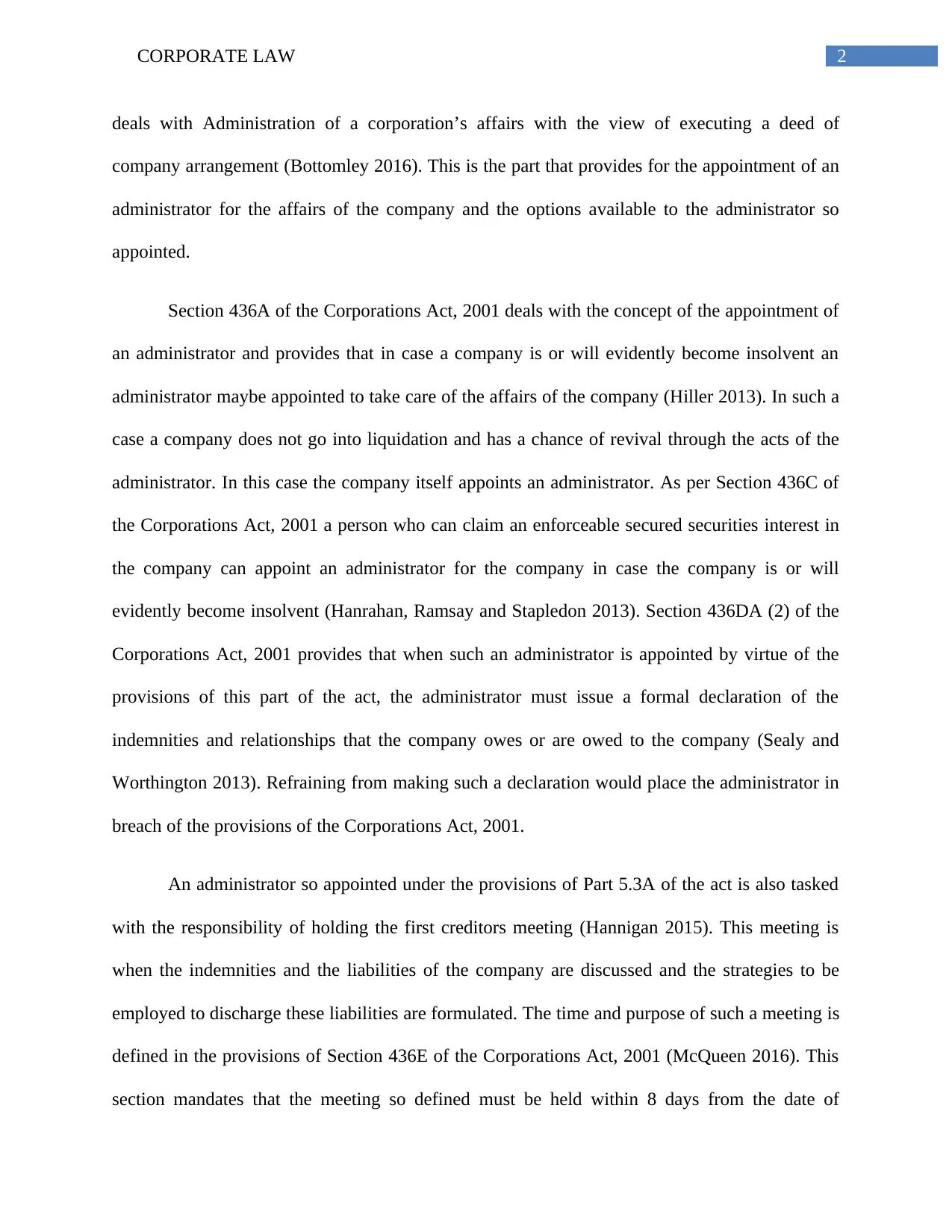
2CORPORATE LAW
deals with Administration of a corporation’s affairs with the view of executing a deed of
company arrangement (Bottomley 2016). This is the part that provides for the appointment of an
administrator for the affairs of the company and the options available to the administrator so
appointed.
Section 436A of the Corporations Act, 2001 deals with the concept of the appointment of
an administrator and provides that in case a company is or will evidently become insolvent an
administrator maybe appointed to take care of the affairs of the company (Hiller 2013). In such a
case a company does not go into liquidation and has a chance of revival through the acts of the
administrator. In this case the company itself appoints an administrator. As per Section 436C of
the Corporations Act, 2001 a person who can claim an enforceable secured securities interest in
the company can appoint an administrator for the company in case the company is or will
evidently become insolvent (Hanrahan, Ramsay and Stapledon 2013). Section 436DA (2) of the
Corporations Act, 2001 provides that when such an administrator is appointed by virtue of the
provisions of this part of the act, the administrator must issue a formal declaration of the
indemnities and relationships that the company owes or are owed to the company (Sealy and
Worthington 2013). Refraining from making such a declaration would place the administrator in
breach of the provisions of the Corporations Act, 2001.
An administrator so appointed under the provisions of Part 5.3A of the act is also tasked
with the responsibility of holding the first creditors meeting (Hannigan 2015). This meeting is
when the indemnities and the liabilities of the company are discussed and the strategies to be
employed to discharge these liabilities are formulated. The time and purpose of such a meeting is
defined in the provisions of Section 436E of the Corporations Act, 2001 (McQueen 2016). This
section mandates that the meeting so defined must be held within 8 days from the date of
deals with Administration of a corporation’s affairs with the view of executing a deed of
company arrangement (Bottomley 2016). This is the part that provides for the appointment of an
administrator for the affairs of the company and the options available to the administrator so
appointed.
Section 436A of the Corporations Act, 2001 deals with the concept of the appointment of
an administrator and provides that in case a company is or will evidently become insolvent an
administrator maybe appointed to take care of the affairs of the company (Hiller 2013). In such a
case a company does not go into liquidation and has a chance of revival through the acts of the
administrator. In this case the company itself appoints an administrator. As per Section 436C of
the Corporations Act, 2001 a person who can claim an enforceable secured securities interest in
the company can appoint an administrator for the company in case the company is or will
evidently become insolvent (Hanrahan, Ramsay and Stapledon 2013). Section 436DA (2) of the
Corporations Act, 2001 provides that when such an administrator is appointed by virtue of the
provisions of this part of the act, the administrator must issue a formal declaration of the
indemnities and relationships that the company owes or are owed to the company (Sealy and
Worthington 2013). Refraining from making such a declaration would place the administrator in
breach of the provisions of the Corporations Act, 2001.
An administrator so appointed under the provisions of Part 5.3A of the act is also tasked
with the responsibility of holding the first creditors meeting (Hannigan 2015). This meeting is
when the indemnities and the liabilities of the company are discussed and the strategies to be
employed to discharge these liabilities are formulated. The time and purpose of such a meeting is
defined in the provisions of Section 436E of the Corporations Act, 2001 (McQueen 2016). This
section mandates that the meeting so defined must be held within 8 days from the date of
⊘ This is a preview!⊘
Do you want full access?
Subscribe today to unlock all pages.

Trusted by 1+ million students worldwide
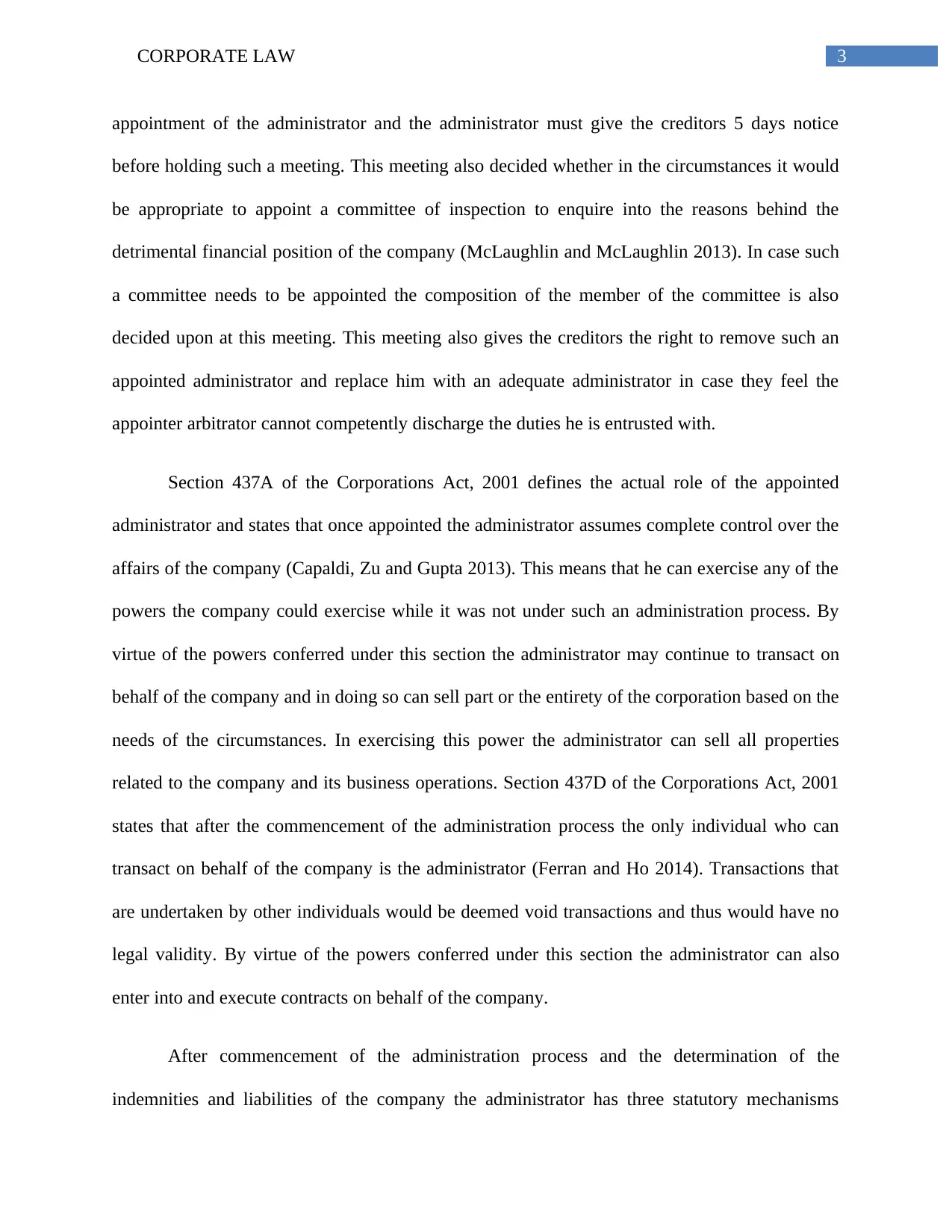
3CORPORATE LAW
appointment of the administrator and the administrator must give the creditors 5 days notice
before holding such a meeting. This meeting also decided whether in the circumstances it would
be appropriate to appoint a committee of inspection to enquire into the reasons behind the
detrimental financial position of the company (McLaughlin and McLaughlin 2013). In case such
a committee needs to be appointed the composition of the member of the committee is also
decided upon at this meeting. This meeting also gives the creditors the right to remove such an
appointed administrator and replace him with an adequate administrator in case they feel the
appointer arbitrator cannot competently discharge the duties he is entrusted with.
Section 437A of the Corporations Act, 2001 defines the actual role of the appointed
administrator and states that once appointed the administrator assumes complete control over the
affairs of the company (Capaldi, Zu and Gupta 2013). This means that he can exercise any of the
powers the company could exercise while it was not under such an administration process. By
virtue of the powers conferred under this section the administrator may continue to transact on
behalf of the company and in doing so can sell part or the entirety of the corporation based on the
needs of the circumstances. In exercising this power the administrator can sell all properties
related to the company and its business operations. Section 437D of the Corporations Act, 2001
states that after the commencement of the administration process the only individual who can
transact on behalf of the company is the administrator (Ferran and Ho 2014). Transactions that
are undertaken by other individuals would be deemed void transactions and thus would have no
legal validity. By virtue of the powers conferred under this section the administrator can also
enter into and execute contracts on behalf of the company.
After commencement of the administration process and the determination of the
indemnities and liabilities of the company the administrator has three statutory mechanisms
appointment of the administrator and the administrator must give the creditors 5 days notice
before holding such a meeting. This meeting also decided whether in the circumstances it would
be appropriate to appoint a committee of inspection to enquire into the reasons behind the
detrimental financial position of the company (McLaughlin and McLaughlin 2013). In case such
a committee needs to be appointed the composition of the member of the committee is also
decided upon at this meeting. This meeting also gives the creditors the right to remove such an
appointed administrator and replace him with an adequate administrator in case they feel the
appointer arbitrator cannot competently discharge the duties he is entrusted with.
Section 437A of the Corporations Act, 2001 defines the actual role of the appointed
administrator and states that once appointed the administrator assumes complete control over the
affairs of the company (Capaldi, Zu and Gupta 2013). This means that he can exercise any of the
powers the company could exercise while it was not under such an administration process. By
virtue of the powers conferred under this section the administrator may continue to transact on
behalf of the company and in doing so can sell part or the entirety of the corporation based on the
needs of the circumstances. In exercising this power the administrator can sell all properties
related to the company and its business operations. Section 437D of the Corporations Act, 2001
states that after the commencement of the administration process the only individual who can
transact on behalf of the company is the administrator (Ferran and Ho 2014). Transactions that
are undertaken by other individuals would be deemed void transactions and thus would have no
legal validity. By virtue of the powers conferred under this section the administrator can also
enter into and execute contracts on behalf of the company.
After commencement of the administration process and the determination of the
indemnities and liabilities of the company the administrator has three statutory mechanisms
Paraphrase This Document
Need a fresh take? Get an instant paraphrase of this document with our AI Paraphraser
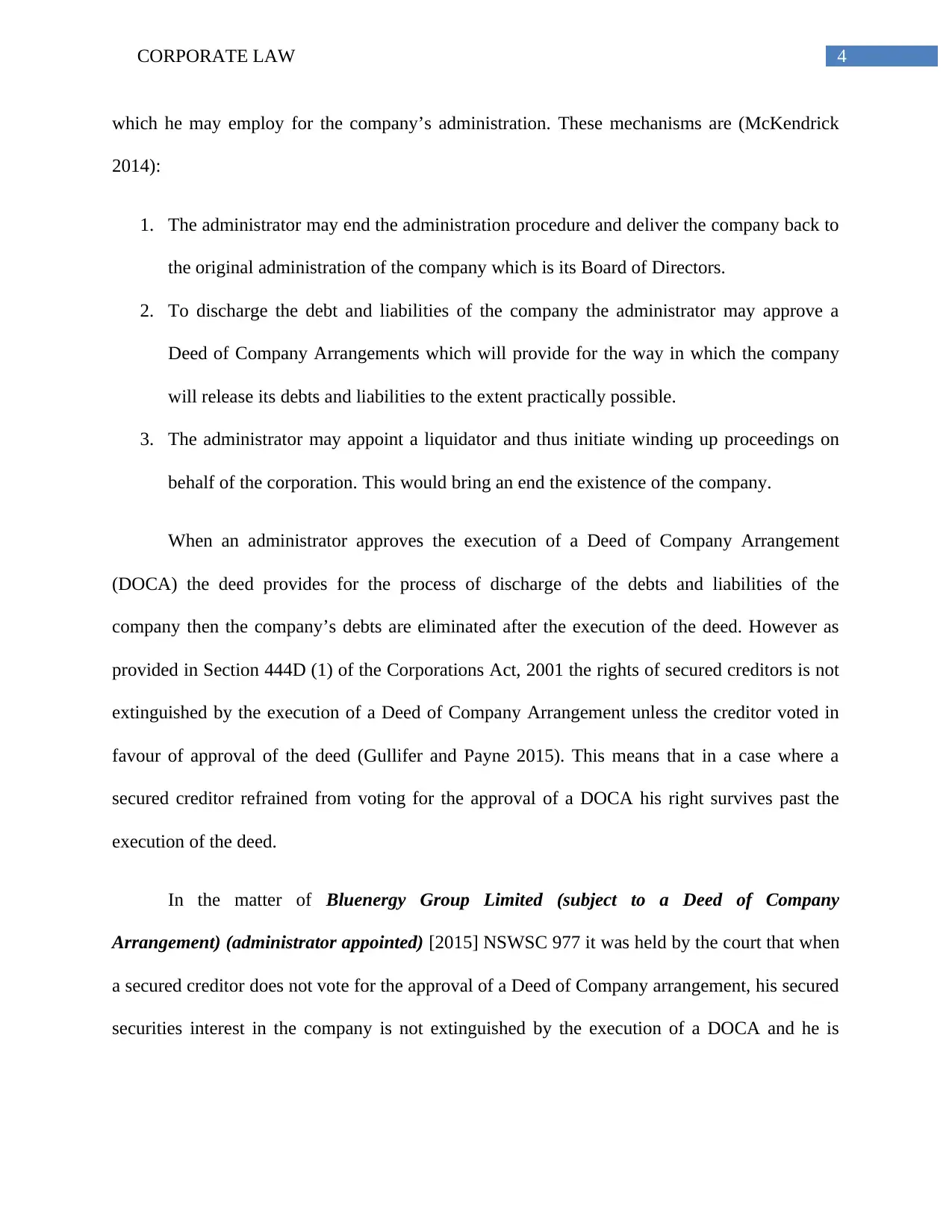
4CORPORATE LAW
which he may employ for the company’s administration. These mechanisms are (McKendrick
2014):
1. The administrator may end the administration procedure and deliver the company back to
the original administration of the company which is its Board of Directors.
2. To discharge the debt and liabilities of the company the administrator may approve a
Deed of Company Arrangements which will provide for the way in which the company
will release its debts and liabilities to the extent practically possible.
3. The administrator may appoint a liquidator and thus initiate winding up proceedings on
behalf of the corporation. This would bring an end the existence of the company.
When an administrator approves the execution of a Deed of Company Arrangement
(DOCA) the deed provides for the process of discharge of the debts and liabilities of the
company then the company’s debts are eliminated after the execution of the deed. However as
provided in Section 444D (1) of the Corporations Act, 2001 the rights of secured creditors is not
extinguished by the execution of a Deed of Company Arrangement unless the creditor voted in
favour of approval of the deed (Gullifer and Payne 2015). This means that in a case where a
secured creditor refrained from voting for the approval of a DOCA his right survives past the
execution of the deed.
In the matter of Bluenergy Group Limited (subject to a Deed of Company
Arrangement) (administrator appointed) [2015] NSWSC 977 it was held by the court that when
a secured creditor does not vote for the approval of a Deed of Company arrangement, his secured
securities interest in the company is not extinguished by the execution of a DOCA and he is
which he may employ for the company’s administration. These mechanisms are (McKendrick
2014):
1. The administrator may end the administration procedure and deliver the company back to
the original administration of the company which is its Board of Directors.
2. To discharge the debt and liabilities of the company the administrator may approve a
Deed of Company Arrangements which will provide for the way in which the company
will release its debts and liabilities to the extent practically possible.
3. The administrator may appoint a liquidator and thus initiate winding up proceedings on
behalf of the corporation. This would bring an end the existence of the company.
When an administrator approves the execution of a Deed of Company Arrangement
(DOCA) the deed provides for the process of discharge of the debts and liabilities of the
company then the company’s debts are eliminated after the execution of the deed. However as
provided in Section 444D (1) of the Corporations Act, 2001 the rights of secured creditors is not
extinguished by the execution of a Deed of Company Arrangement unless the creditor voted in
favour of approval of the deed (Gullifer and Payne 2015). This means that in a case where a
secured creditor refrained from voting for the approval of a DOCA his right survives past the
execution of the deed.
In the matter of Bluenergy Group Limited (subject to a Deed of Company
Arrangement) (administrator appointed) [2015] NSWSC 977 it was held by the court that when
a secured creditor does not vote for the approval of a Deed of Company arrangement, his secured
securities interest in the company is not extinguished by the execution of a DOCA and he is
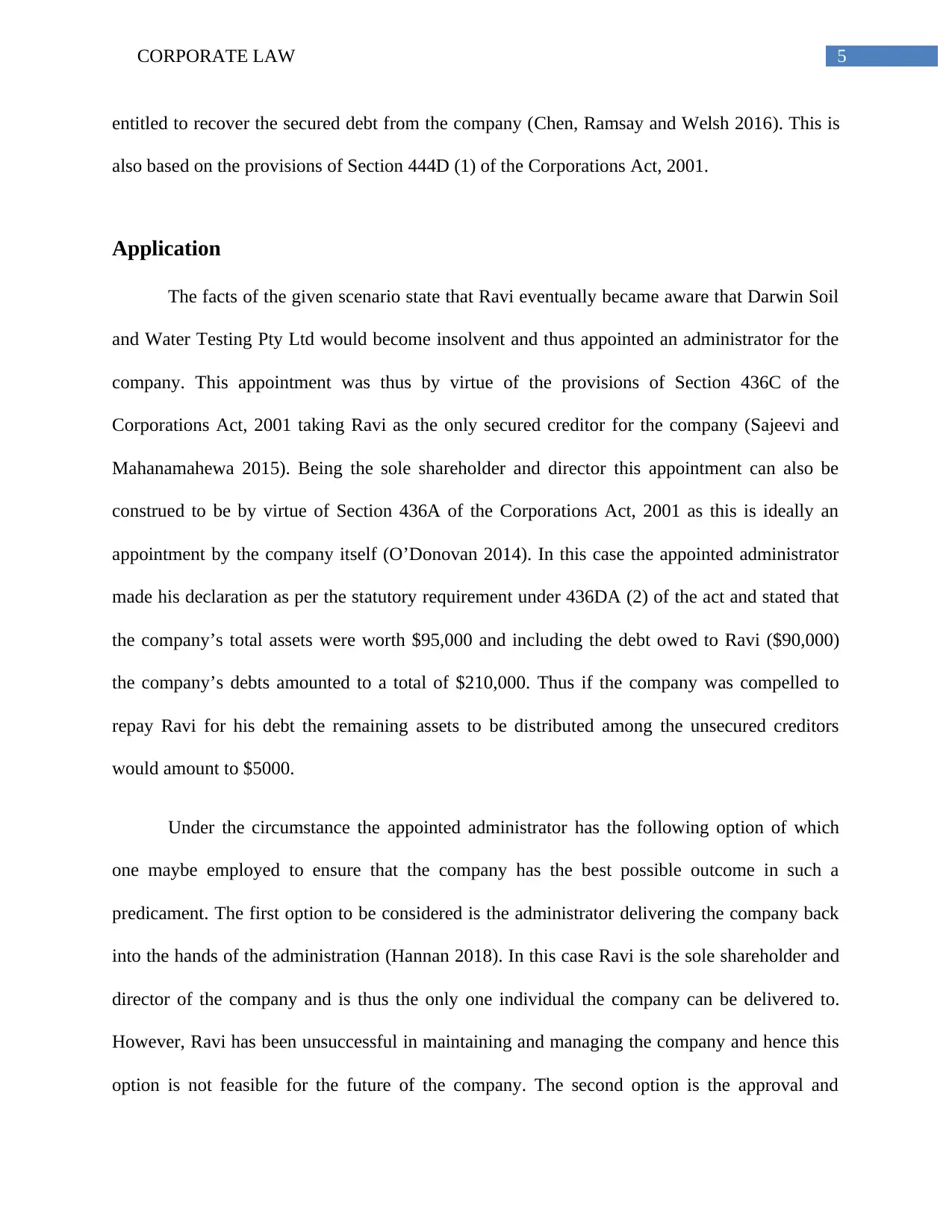
5CORPORATE LAW
entitled to recover the secured debt from the company (Chen, Ramsay and Welsh 2016). This is
also based on the provisions of Section 444D (1) of the Corporations Act, 2001.
Application
The facts of the given scenario state that Ravi eventually became aware that Darwin Soil
and Water Testing Pty Ltd would become insolvent and thus appointed an administrator for the
company. This appointment was thus by virtue of the provisions of Section 436C of the
Corporations Act, 2001 taking Ravi as the only secured creditor for the company (Sajeevi and
Mahanamahewa 2015). Being the sole shareholder and director this appointment can also be
construed to be by virtue of Section 436A of the Corporations Act, 2001 as this is ideally an
appointment by the company itself (O’Donovan 2014). In this case the appointed administrator
made his declaration as per the statutory requirement under 436DA (2) of the act and stated that
the company’s total assets were worth $95,000 and including the debt owed to Ravi ($90,000)
the company’s debts amounted to a total of $210,000. Thus if the company was compelled to
repay Ravi for his debt the remaining assets to be distributed among the unsecured creditors
would amount to $5000.
Under the circumstance the appointed administrator has the following option of which
one maybe employed to ensure that the company has the best possible outcome in such a
predicament. The first option to be considered is the administrator delivering the company back
into the hands of the administration (Hannan 2018). In this case Ravi is the sole shareholder and
director of the company and is thus the only one individual the company can be delivered to.
However, Ravi has been unsuccessful in maintaining and managing the company and hence this
option is not feasible for the future of the company. The second option is the approval and
entitled to recover the secured debt from the company (Chen, Ramsay and Welsh 2016). This is
also based on the provisions of Section 444D (1) of the Corporations Act, 2001.
Application
The facts of the given scenario state that Ravi eventually became aware that Darwin Soil
and Water Testing Pty Ltd would become insolvent and thus appointed an administrator for the
company. This appointment was thus by virtue of the provisions of Section 436C of the
Corporations Act, 2001 taking Ravi as the only secured creditor for the company (Sajeevi and
Mahanamahewa 2015). Being the sole shareholder and director this appointment can also be
construed to be by virtue of Section 436A of the Corporations Act, 2001 as this is ideally an
appointment by the company itself (O’Donovan 2014). In this case the appointed administrator
made his declaration as per the statutory requirement under 436DA (2) of the act and stated that
the company’s total assets were worth $95,000 and including the debt owed to Ravi ($90,000)
the company’s debts amounted to a total of $210,000. Thus if the company was compelled to
repay Ravi for his debt the remaining assets to be distributed among the unsecured creditors
would amount to $5000.
Under the circumstance the appointed administrator has the following option of which
one maybe employed to ensure that the company has the best possible outcome in such a
predicament. The first option to be considered is the administrator delivering the company back
into the hands of the administration (Hannan 2018). In this case Ravi is the sole shareholder and
director of the company and is thus the only one individual the company can be delivered to.
However, Ravi has been unsuccessful in maintaining and managing the company and hence this
option is not feasible for the future of the company. The second option is the approval and
⊘ This is a preview!⊘
Do you want full access?
Subscribe today to unlock all pages.

Trusted by 1+ million students worldwide
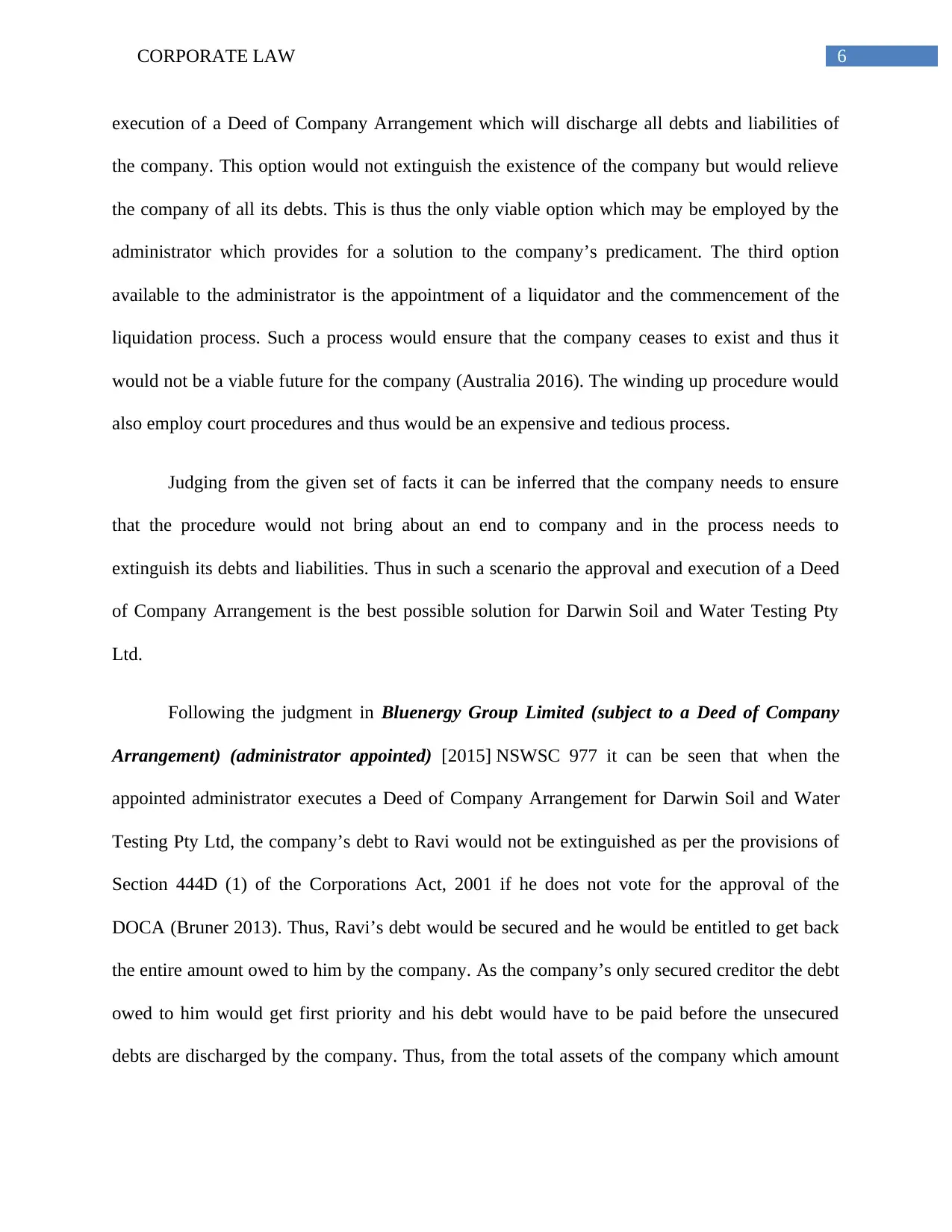
6CORPORATE LAW
execution of a Deed of Company Arrangement which will discharge all debts and liabilities of
the company. This option would not extinguish the existence of the company but would relieve
the company of all its debts. This is thus the only viable option which may be employed by the
administrator which provides for a solution to the company’s predicament. The third option
available to the administrator is the appointment of a liquidator and the commencement of the
liquidation process. Such a process would ensure that the company ceases to exist and thus it
would not be a viable future for the company (Australia 2016). The winding up procedure would
also employ court procedures and thus would be an expensive and tedious process.
Judging from the given set of facts it can be inferred that the company needs to ensure
that the procedure would not bring about an end to company and in the process needs to
extinguish its debts and liabilities. Thus in such a scenario the approval and execution of a Deed
of Company Arrangement is the best possible solution for Darwin Soil and Water Testing Pty
Ltd.
Following the judgment in Bluenergy Group Limited (subject to a Deed of Company
Arrangement) (administrator appointed) [2015] NSWSC 977 it can be seen that when the
appointed administrator executes a Deed of Company Arrangement for Darwin Soil and Water
Testing Pty Ltd, the company’s debt to Ravi would not be extinguished as per the provisions of
Section 444D (1) of the Corporations Act, 2001 if he does not vote for the approval of the
DOCA (Bruner 2013). Thus, Ravi’s debt would be secured and he would be entitled to get back
the entire amount owed to him by the company. As the company’s only secured creditor the debt
owed to him would get first priority and his debt would have to be paid before the unsecured
debts are discharged by the company. Thus, from the total assets of the company which amount
execution of a Deed of Company Arrangement which will discharge all debts and liabilities of
the company. This option would not extinguish the existence of the company but would relieve
the company of all its debts. This is thus the only viable option which may be employed by the
administrator which provides for a solution to the company’s predicament. The third option
available to the administrator is the appointment of a liquidator and the commencement of the
liquidation process. Such a process would ensure that the company ceases to exist and thus it
would not be a viable future for the company (Australia 2016). The winding up procedure would
also employ court procedures and thus would be an expensive and tedious process.
Judging from the given set of facts it can be inferred that the company needs to ensure
that the procedure would not bring about an end to company and in the process needs to
extinguish its debts and liabilities. Thus in such a scenario the approval and execution of a Deed
of Company Arrangement is the best possible solution for Darwin Soil and Water Testing Pty
Ltd.
Following the judgment in Bluenergy Group Limited (subject to a Deed of Company
Arrangement) (administrator appointed) [2015] NSWSC 977 it can be seen that when the
appointed administrator executes a Deed of Company Arrangement for Darwin Soil and Water
Testing Pty Ltd, the company’s debt to Ravi would not be extinguished as per the provisions of
Section 444D (1) of the Corporations Act, 2001 if he does not vote for the approval of the
DOCA (Bruner 2013). Thus, Ravi’s debt would be secured and he would be entitled to get back
the entire amount owed to him by the company. As the company’s only secured creditor the debt
owed to him would get first priority and his debt would have to be paid before the unsecured
debts are discharged by the company. Thus, from the total assets of the company which amount
Paraphrase This Document
Need a fresh take? Get an instant paraphrase of this document with our AI Paraphraser
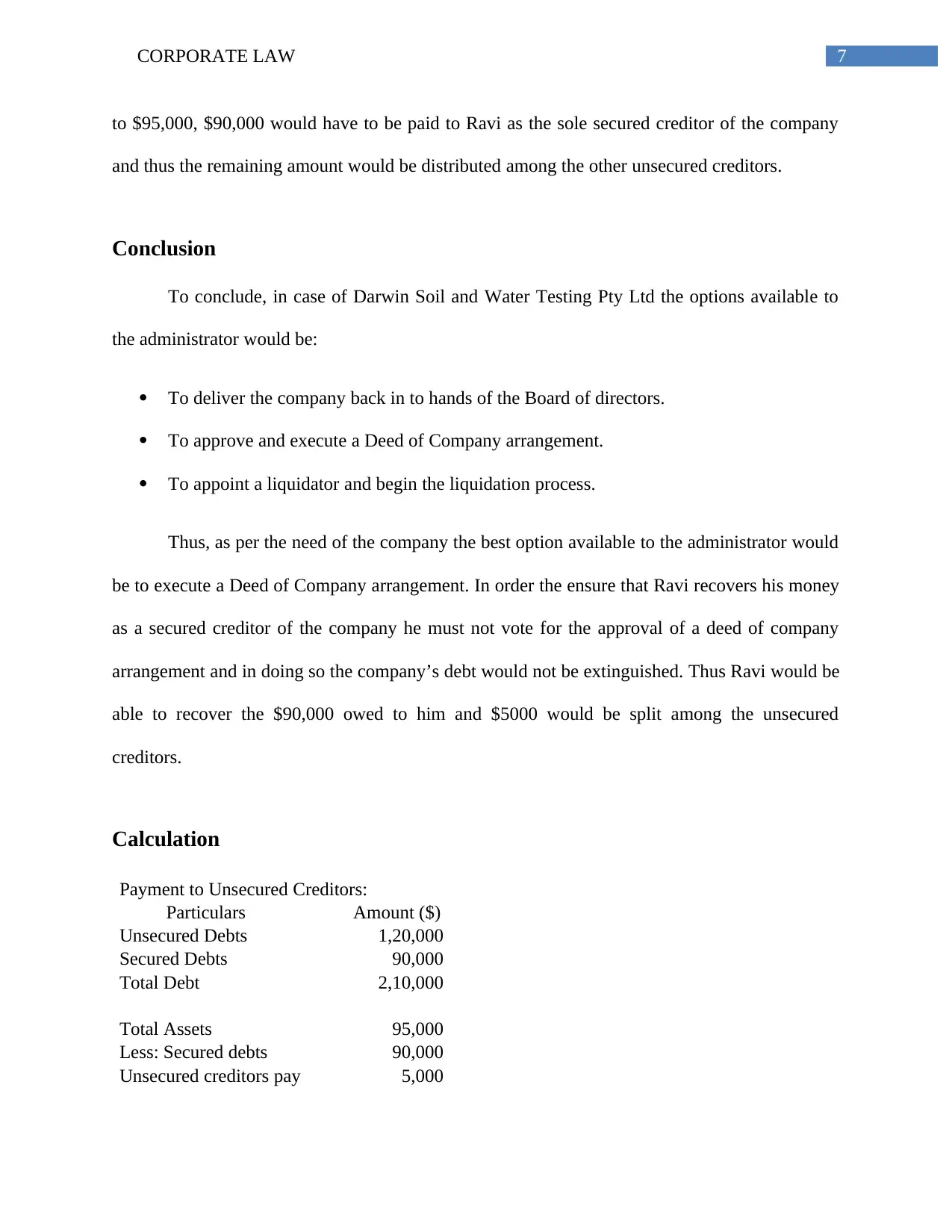
7CORPORATE LAW
to $95,000, $90,000 would have to be paid to Ravi as the sole secured creditor of the company
and thus the remaining amount would be distributed among the other unsecured creditors.
Conclusion
To conclude, in case of Darwin Soil and Water Testing Pty Ltd the options available to
the administrator would be:
To deliver the company back in to hands of the Board of directors.
To approve and execute a Deed of Company arrangement.
To appoint a liquidator and begin the liquidation process.
Thus, as per the need of the company the best option available to the administrator would
be to execute a Deed of Company arrangement. In order the ensure that Ravi recovers his money
as a secured creditor of the company he must not vote for the approval of a deed of company
arrangement and in doing so the company’s debt would not be extinguished. Thus Ravi would be
able to recover the $90,000 owed to him and $5000 would be split among the unsecured
creditors.
Calculation
Payment to Unsecured Creditors:
Particulars Amount ($)
Unsecured Debts 1,20,000
Secured Debts 90,000
Total Debt 2,10,000
Total Assets 95,000
Less: Secured debts 90,000
Unsecured creditors pay 5,000
to $95,000, $90,000 would have to be paid to Ravi as the sole secured creditor of the company
and thus the remaining amount would be distributed among the other unsecured creditors.
Conclusion
To conclude, in case of Darwin Soil and Water Testing Pty Ltd the options available to
the administrator would be:
To deliver the company back in to hands of the Board of directors.
To approve and execute a Deed of Company arrangement.
To appoint a liquidator and begin the liquidation process.
Thus, as per the need of the company the best option available to the administrator would
be to execute a Deed of Company arrangement. In order the ensure that Ravi recovers his money
as a secured creditor of the company he must not vote for the approval of a deed of company
arrangement and in doing so the company’s debt would not be extinguished. Thus Ravi would be
able to recover the $90,000 owed to him and $5000 would be split among the unsecured
creditors.
Calculation
Payment to Unsecured Creditors:
Particulars Amount ($)
Unsecured Debts 1,20,000
Secured Debts 90,000
Total Debt 2,10,000
Total Assets 95,000
Less: Secured debts 90,000
Unsecured creditors pay 5,000
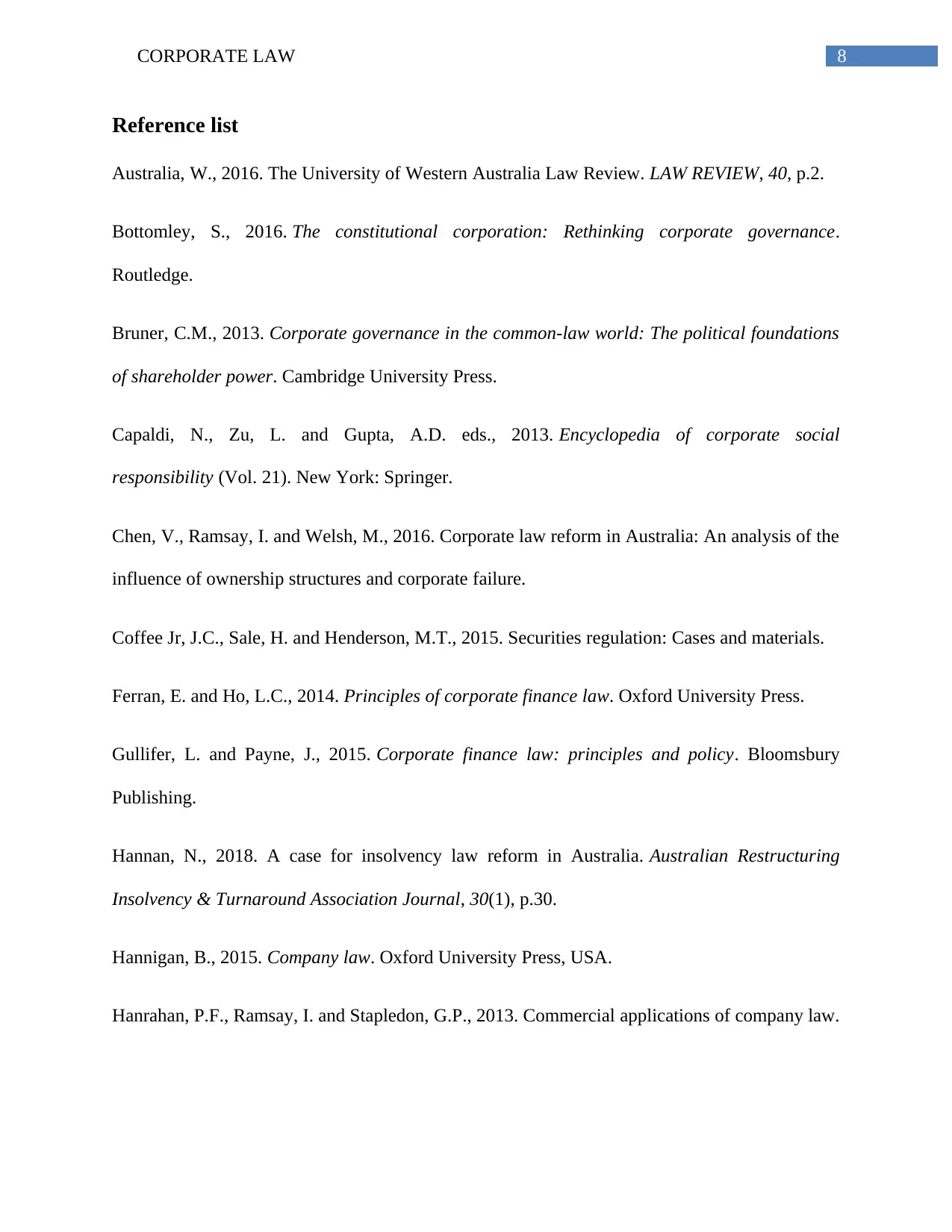
8CORPORATE LAW
Reference list
Australia, W., 2016. The University of Western Australia Law Review. LAW REVIEW, 40, p.2.
Bottomley, S., 2016. The constitutional corporation: Rethinking corporate governance.
Routledge.
Bruner, C.M., 2013. Corporate governance in the common-law world: The political foundations
of shareholder power. Cambridge University Press.
Capaldi, N., Zu, L. and Gupta, A.D. eds., 2013. Encyclopedia of corporate social
responsibility (Vol. 21). New York: Springer.
Chen, V., Ramsay, I. and Welsh, M., 2016. Corporate law reform in Australia: An analysis of the
influence of ownership structures and corporate failure.
Coffee Jr, J.C., Sale, H. and Henderson, M.T., 2015. Securities regulation: Cases and materials.
Ferran, E. and Ho, L.C., 2014. Principles of corporate finance law. Oxford University Press.
Gullifer, L. and Payne, J., 2015. Corporate finance law: principles and policy. Bloomsbury
Publishing.
Hannan, N., 2018. A case for insolvency law reform in Australia. Australian Restructuring
Insolvency & Turnaround Association Journal, 30(1), p.30.
Hannigan, B., 2015. Company law. Oxford University Press, USA.
Hanrahan, P.F., Ramsay, I. and Stapledon, G.P., 2013. Commercial applications of company law.
Reference list
Australia, W., 2016. The University of Western Australia Law Review. LAW REVIEW, 40, p.2.
Bottomley, S., 2016. The constitutional corporation: Rethinking corporate governance.
Routledge.
Bruner, C.M., 2013. Corporate governance in the common-law world: The political foundations
of shareholder power. Cambridge University Press.
Capaldi, N., Zu, L. and Gupta, A.D. eds., 2013. Encyclopedia of corporate social
responsibility (Vol. 21). New York: Springer.
Chen, V., Ramsay, I. and Welsh, M., 2016. Corporate law reform in Australia: An analysis of the
influence of ownership structures and corporate failure.
Coffee Jr, J.C., Sale, H. and Henderson, M.T., 2015. Securities regulation: Cases and materials.
Ferran, E. and Ho, L.C., 2014. Principles of corporate finance law. Oxford University Press.
Gullifer, L. and Payne, J., 2015. Corporate finance law: principles and policy. Bloomsbury
Publishing.
Hannan, N., 2018. A case for insolvency law reform in Australia. Australian Restructuring
Insolvency & Turnaround Association Journal, 30(1), p.30.
Hannigan, B., 2015. Company law. Oxford University Press, USA.
Hanrahan, P.F., Ramsay, I. and Stapledon, G.P., 2013. Commercial applications of company law.
⊘ This is a preview!⊘
Do you want full access?
Subscribe today to unlock all pages.

Trusted by 1+ million students worldwide
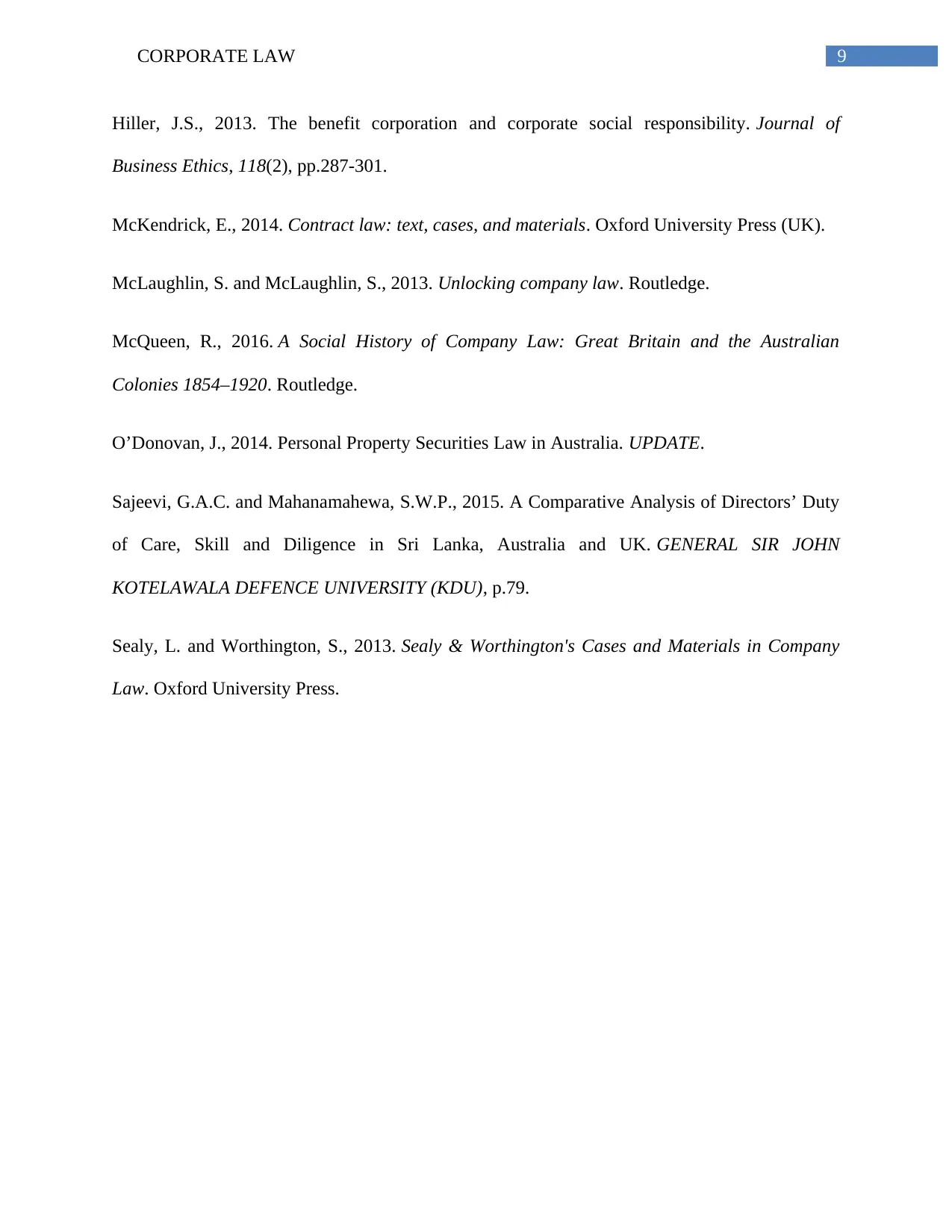
9CORPORATE LAW
Hiller, J.S., 2013. The benefit corporation and corporate social responsibility. Journal of
Business Ethics, 118(2), pp.287-301.
McKendrick, E., 2014. Contract law: text, cases, and materials. Oxford University Press (UK).
McLaughlin, S. and McLaughlin, S., 2013. Unlocking company law. Routledge.
McQueen, R., 2016. A Social History of Company Law: Great Britain and the Australian
Colonies 1854–1920. Routledge.
O’Donovan, J., 2014. Personal Property Securities Law in Australia. UPDATE.
Sajeevi, G.A.C. and Mahanamahewa, S.W.P., 2015. A Comparative Analysis of Directors’ Duty
of Care, Skill and Diligence in Sri Lanka, Australia and UK. GENERAL SIR JOHN
KOTELAWALA DEFENCE UNIVERSITY (KDU), p.79.
Sealy, L. and Worthington, S., 2013. Sealy & Worthington's Cases and Materials in Company
Law. Oxford University Press.
Hiller, J.S., 2013. The benefit corporation and corporate social responsibility. Journal of
Business Ethics, 118(2), pp.287-301.
McKendrick, E., 2014. Contract law: text, cases, and materials. Oxford University Press (UK).
McLaughlin, S. and McLaughlin, S., 2013. Unlocking company law. Routledge.
McQueen, R., 2016. A Social History of Company Law: Great Britain and the Australian
Colonies 1854–1920. Routledge.
O’Donovan, J., 2014. Personal Property Securities Law in Australia. UPDATE.
Sajeevi, G.A.C. and Mahanamahewa, S.W.P., 2015. A Comparative Analysis of Directors’ Duty
of Care, Skill and Diligence in Sri Lanka, Australia and UK. GENERAL SIR JOHN
KOTELAWALA DEFENCE UNIVERSITY (KDU), p.79.
Sealy, L. and Worthington, S., 2013. Sealy & Worthington's Cases and Materials in Company
Law. Oxford University Press.
1 out of 10
Related Documents
Your All-in-One AI-Powered Toolkit for Academic Success.
+13062052269
info@desklib.com
Available 24*7 on WhatsApp / Email
![[object Object]](/_next/static/media/star-bottom.7253800d.svg)
Unlock your academic potential
Copyright © 2020–2025 A2Z Services. All Rights Reserved. Developed and managed by ZUCOL.




